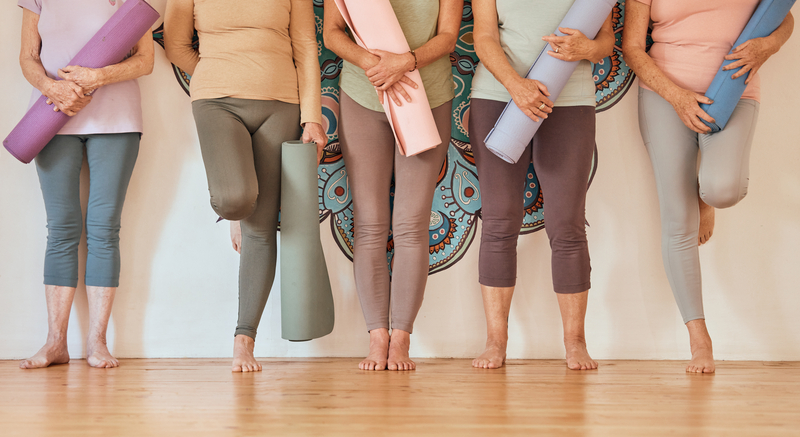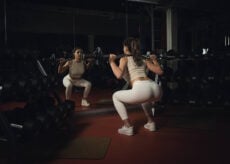Wall Pilates: Is It Worth It? (And 9 of the best moves)

You can improve your strength, posture, and even your flexibility with wall Pilates. Adding the use of a wall to your tried-and-true Pilates moves can level up your workout and bring you the added benefits of increased resistance training and exercise intensity. Here are 9 moves to enjoy this fun twist on an old standard.
What Is Wall Pilates?
It may be best to start with the question, “What is Pilates?” Pilates is a type of exercise developed in the early 1900s by a man named Joseph Hubertus Pilates. He originally called it “Contrology,” and his goal was to combine movements that would strengthen your ability to control the mind, body, and spirit. Pilates was also designed to help you align your body while becoming more flexible.
“Wall Pilates” is the next step up from regular Pilates. Wall Pilates brings another facet of resistance into your workouts. By engaging a wall, you add gravity and resistance to the mix to target specific muscles and ramp up the intensity of regular Pilates moves. Yet it also decreases the intensity of other movements, so you can focus on your form as you gain strength and flexibility.
Benefits of Wall Pilates
While Pilates may just appear to be “stretching,” it’s actually much more involved than that and provides a host of benefits. Pilates helps you make a mind-body connection while promoting flexibility, proper posture, a stronger core, and better body alignment.
Wall Pilates takes it all to the next level by allowing you to add resistance as well as stability to your moves. For example, if you’re working on your balance and alignment, having the wall for backup can keep your movements in the proper plane and help you develop better movement patterns.
Wall Pilates is also something you can do virtually anywhere. You don’t need any equipment to get a great workout—just an empty wall!
Here Are the Best Wall Pilates Moves
Are you ready to try some Wall Pilates moves for yourself? Here are some of the best moves.
- Wall Bridges—Start on your back and place your feet on the wall, knees bent, with your arms by your sides. Lift your hips up off the floor while you press your feet into the wall and squeeze your glutes to form a “bridge.” Hold this position for a count of five, and then return to the start.
Bent Leg Wall 100s—This is a twist on the famous “100s” Pilates exercise. Start by lying on your back and place your feet on the wall, a few inches off the floor. Lift your head and shoulders slightly off the ground and bring your straight arms up next to your hips. Pump your arms slightly up and down in quick movements while keeping your core tight. Breathe in for a count of five and then out for a count of five. Keep going until you reach a hundred repetitions with your arms before you return to the starting position.
Wall Planks—Start by standing about an arm’s length away from the wall, facing the wall. Place your palms on the wall about shoulder-width apart. Next, bend at the elbows until you can completely rest your forearms on the wall. Hold this plank position for 60 seconds, and then straighten your arms to push back to the starting position.
Wall Squats—This may sound familiar, and it should be! Start by standing with your back and butt against the wall. Move your feet outward until you can comfortably slide down the wall into a “sitting” position while keeping your feet flat and your knees bent until your thighs are at least parallel with the floor. Hold this sitting squat position for 30 to 60 seconds, depending on your ability. Push back to the start by straightening your legs as you slide your back up the wall to stand again.
Wall Squats with Ball Squeeze—Doing a wall squat with a ball (medicine ball or other medium-sized ball) between your knees can help you work on your adductor muscles. These inner thigh muscles can sometimes get neglected if not directly addressed with adductor-specific movements.
Start as you did for the regular wall squats, except place the ball between your knees. Squeeze the ball hard enough to keep it in place as you bend at the knees and slide your back down the wall into a squat position. Hold this stance for 30 to 60 seconds, and then straighten your legs to go back to the start.
Wide Wall Push-Ups—Start by standing with your feet about hip-width apart and arms-length away from the wall. Place your palms on the wall in front of your chest at a slightly wider-than-shoulder width. Next, keeping your body straight, bend at the elbows to move your upper body into a push-up position, bringing your chest as close as you can to the wall. Hold that position for a count of three, and then straighten your arms while squeezing your chest muscles to propel yourself back to the start.
Wall-Assisted Single Leg Circles—Start by standing with your back against the wall with your feet about hip-width apart. Place your hands next to your hips with your palms touching the wall. Next, lift your right leg out straight in front of you, about six inches off the ground. Point your toes and draw small clockwise circles in the air. Do ten in one direction and then do ten more in the other direction. Return your right leg to the starting position and repeat the sequence for your left leg.
Angel Arms—Start by standing with your back, butt, and heels touching the wall with your arms down by your sides. Keeping your arms touching the wall, bring them out to your sides and then up overhead to touch and then back down to your sides again. Try with both palms facing toward the wall and palms away from the wall.
Chest Wall Stretch—Stand facing the wall with your arms out to each side, palms touching the wall. Next, step slowly and turn out to your left. Bring your left arm away from the wall while keeping your right arm in place. You’ll feel a good stretch through your right chest and shoulder region. Bring your left arm back to the wall, and repeat on the opposite side.
Now that you see how you can incorporate the wall into your basic Pilates moves, try making up some of your own. You can try doing lunges, side lunges, leg lifts, kicks, roll-downs, and more. Use wall Pilates to your advantage to make your workouts more effective and maybe even a little more fun!




 7 Signs Your Body is Seriously Low on Collagen (not just wrinkles)
7 Signs Your Body is Seriously Low on Collagen (not just wrinkles) Health Expert: "Turmeric Doesn't Work (unless...)"
Health Expert: "Turmeric Doesn't Work (unless...)" 3 Warning Signs Your Probiotic Supplement is a Total Waste
3 Warning Signs Your Probiotic Supplement is a Total Waste

